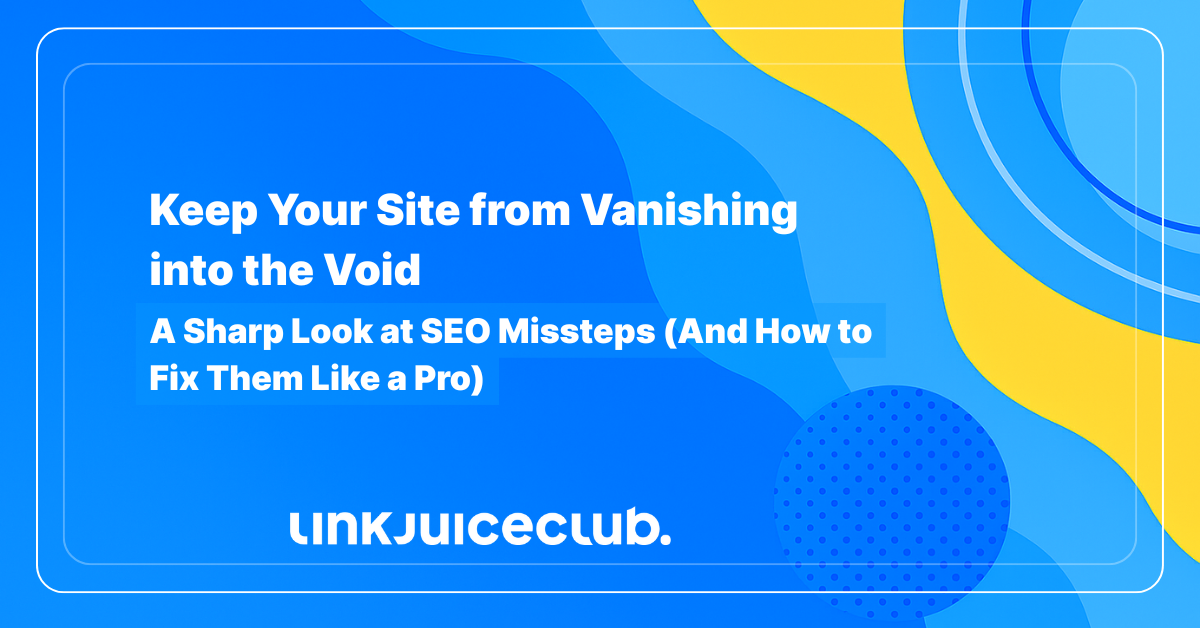
Keep Your Site from Vanishing into the Void: A Sharp Look at SEO Missteps (And How to Fix Them Like a Pro)
Let’s set the scene. You’ve launched a website. You’ve sweated over the copy, spent hours resizing images that somehow always look blurry, and even signed up for one of those SEO plugins that promises to “get you on page one”. You feel proud, hopeful even. But days, weeks, months later, the traffic still looks like a sleepy Sunday car park. Nobody’s visiting, clicks are as rare as a sunny day in February, and you’re wondering if Google has something personal against you.
The truth is much less dramatic. Most websites struggle with search visibility not because of some elusive algorithmic grudge, but because of basic SEO mistakes. Often subtle, sometimes spectacular, these mistakes quietly sabotage your site’s potential. But here’s the silver lining: with a bit of attention and some strategic elbow grease, nearly all of them are avoidable.

So let’s break it down properly. Not with fluff, not with corporate nonsense. This is your no-fuss, full-disclosure walkthrough of the biggest SEO pitfalls and, crucially, how to sidestep them with style.
Why Getting SEO Right Actually Matters More Than You Think
At its core, SEO (Search Engine Optimisation) is about helping search engines understand your site, your pages, and your content. When Google can easily figure out who you are and what you do, it’s more likely to send relevant people your way.
But if your website looks to Google like an unsorted toolbox, random bits everywhere, rusty labels, and three broken screwdrivers, you’ll end up buried under pages of results that no one ever sees.
The worst part? Many of the most damaging SEO mistakes are not exotic technical errors. They’re everyday misjudgements. Like writing content without a clear purpose, ignoring site speed, or forgetting to connect your pages together properly. These things don’t sound catastrophic, but they act like slow poison for your visibility.
The upside? You can prevent or fix nearly every one of them without needing to hire a team of digital monks. But before we get into the meat of that, let’s talk a little more about how easily SEO can go wrong and why so many people let it.
A Word on How Ridiculously Easy It Is to Botch SEO
SEO mistakes don’t often arrive with a crash and a warning siren. They slip in unnoticed. You might think your site looks fine. After all, it loads, it scrolls, and it says what you want it to say. But Google is looking for more than that. It’s peeking under the bonnet, measuring response times, checking whether your keywords match what people actually type into search bars, and watching how users behave on your pages.
If visitors come, frown, and leave faster than they can say “back button”, Google takes it as a bad sign. It assumes your content wasn’t useful and gently demotes you in the rankings.
Most of these issues could have been avoided with a solid checklist and a few regular reviews. But because they don’t cause an immediate crisis, they linger. Like a dripping tap, they cost you dearly over time without ever sounding an alarm.
The Six Blunders that Sabotage Your SEO (And How to Build a Bulletproof Strategy Instead)
So, if the goal is to give the website a fair shot, it’s time to roll up those sleeves. The next section breaks down six of the most common SEO mistakes, explains why they matter, and shows exactly how to sort them without inviting a nervous breakdown.
🧠1. Forgetting the Humans Behind the Search Terms
One of the biggest missteps in SEO is writing purely for search engines and forgetting the person actually reading. Content overloaded with keywords, but offering no real help, might have worked ten years ago, but today, it’s a fast way to fall in rankings.
Search engines now prioritise intent and usefulness. If someone is searching for tips on cleaning suede shoes, they don’t want a wall of irrelevant history about leather. They want clear, actionable steps that solve their problem.
The best approach is to focus on the needs behind the query and to write as if explaining something to a friend who genuinely needs it.
To get this right, tools like Google’s autocomplete, AnswerThePublic, or even reading the “People also ask” box can help map out the specific questions your audience wants answered.
Structuring your content in a way that clearly addresses those needs, using logical subheadings, clean formatting, and concise, valuable copy, will serve both readers and search engines well.
🐢 2. Neglecting Page Speed Like It’s Just a Minor Issue
Allowing your website to load at the pace of a dial-up connection circa 1997 is a recipe for disaster. It might sound like a dramatic comparison, but for users accustomed to lightning-fast responses, even a few seconds of delay feels prehistoric.
Speed matters enormously for both user experience and search rankings, especially on mobile devices where attention spans are even shorter.
The good news is that boosting speed isn’t as complicated as it seems. Compressing images, enabling browser caching, reducing unnecessary code, and choosing a decent hosting service go a long way.
Tools like Google PageSpeed Insights and WebPageTest can identify problem areas and offer step-by-step suggestions. It’s smart to build the habit of checking speed regularly, particularly after publishing new content or installing new plugins. Treat it like checking the tyre pressure on a car: boring but essential if you don’t want something blowing out on the motorway.
🔗3. Ignoring Internal Linking, aka Living on SEO Island
Another common oversight is leaving pages disconnected from each other, as if each one lives in its own private universe.
Internal linking plays a major role in guiding search engines around your site and helps visitors discover more of your content. Without it, your pages are floating in isolation, and both users and crawlers may struggle to see the bigger picture.
Building strong internal links means intentionally creating pathways between related pieces of content. This helps spread authority across your pages while improving the overall structure and user flow at the same time.
For example, if there’s a guide on home workouts, it makes sense to link out to more specific posts on resistance bands, bodyweight routines, and stretching.
Developing topic clusters or content hubs like this adds coherence, makes your site easier to explore, and encourages longer user sessions, all of which are music to Google’s ears.
🏷️4. Skipping Title Tags and Meta Descriptions Like They’re Optional
Some sites treat metadata like an afterthought, leaving title tags and meta descriptions to be auto-filled or duplicated across pages. That’s a mistake.
These two small snippets are often the first thing someone sees in search results, and if they’re bland, confusing, or missing altogether, potential visitors will scroll right past.
Crafting unique and enticing titles and descriptions for every page significantly improves click-through rates. It’s best to think of the title tag as the headline of a newspaper article, something short, punchy, and clear, while the meta description serves as the teaser paragraph.
Including a relevant keyword is still important, but the real goal is to give the searcher a compelling reason to click.
Keep title tags under 60 characters and meta descriptions under 160. Prioritise clarity, benefit-driven language, and avoid stuffing in so many keywords that it sounds like an awkward sales pitch. It’s not about tricking Google; it’s about attracting the right audience.
📱5. Failing to Make Your Site Mobile-Friendly
Many websites still look and function beautifully on desktop, but fall apart when viewed on a phone. That’s a serious problem, considering the majority of web traffic now comes from mobile devices.
Google uses mobile-first indexing, which means the mobile version of your site is the one that gets judged first. If it’s clunky, slow, or unreadable, your rankings will suffer, even if your desktop experience is spotless.
Ensuring mobile-friendliness means having a responsive design that adapts to different screen sizes, buttons that are easy to tap, menus that are intuitive, and text that doesn’t require squinting.
Google’s Mobile-Friendly Test tool makes it easy to identify problem areas. Investing time in creating a seamless mobile experience isn’t just good SEO practice; it’s critical for retaining users who are quick to bounce if things feel broken or difficult.
🧩6. Indexing Chaos: Blocking Pages You Shouldn’t or Forgetting to Block What You Should
A site can fall into SEO mistakes based on what it displays to users as well as what it allows Google to access.
Indexing mismanagement is a surprisingly frequent issue. Either the important pages are being accidentally hidden, or clutter pages (like thank-you pages, duplicate filters, or internal searches) are being indexed for no good reason.
This confuses search engines and waters down your site’s authority. Sorting this out begins with reviewing the robots.txt file and sitemap to ensure they accurately reflect which pages should be crawled.
Using noindex tags for non-essential pages, and setting canonical URLs for duplicates, helps keep things tidy. Google Search Console offers clear reports showing which pages are indexed, blocked, or causing errors. With a bit of attention and discipline, you can guide Google through your site like a well-organised museum tour, rather than sending it wandering aimlessly through the storage cupboards.
Building a Strong, Sensible SEO Foundation from the Ground Up
Rather than playing whack-a-mole with mistakes, aim for a structured system. Here’s how to build a dependable SEO strategy that actually scales:
- Start with a crawl: Use a tool like Screaming Frog or Sitebulb to scan your site and catch technical issues early.
- Keyword research is non-negotiable: Use Google Keyword Planner, Ahrefs, or Semrush. Understand what people are searching for and tailor your pages to those phrases.
- Content planning beats content dumping: Plan around topics, not just keywords. Build clusters. Prioritise relevance and quality.
- Regular health checks: Once a month, revisit your site structure, check speed, audit internal links, and update outdated content.
- Track results like a hawk: Set up Search Console and Google Analytics. Monitor what content performs, and build more of what works.
SEO Isn’t a Mystery, It’s a Craft
SEO isn’t a one-time fix or a lucky break. It’s a practice, a rhythm, like sharpening tools in a workshop or tuning your car before winter. The more attention you give it, the smoother things run, and the easier it becomes to avoid the potholes.
So don’t let your hard work go unseen. Fix the obvious mistakes. Learn the system. Remember that in the world of search, visibility is earned through clarity, consistency and care.
The best part? Once you get it right, SEO works for you day and night. While you sleep, it quietly brings in traffic, leads and opportunities, without needing to shout, advertise or pay for every single click.
That’s the kind of digital advantage worth doing properly.





